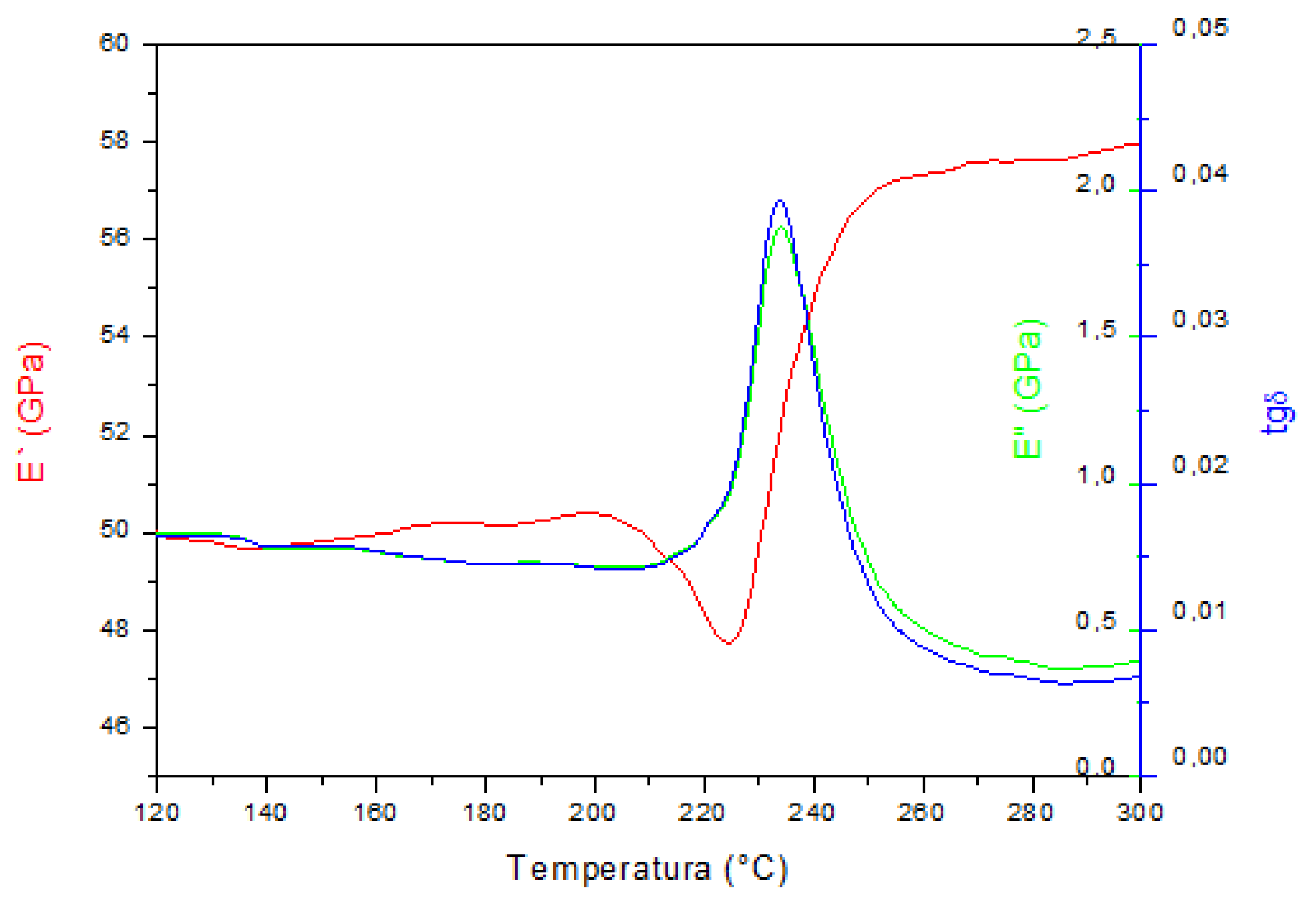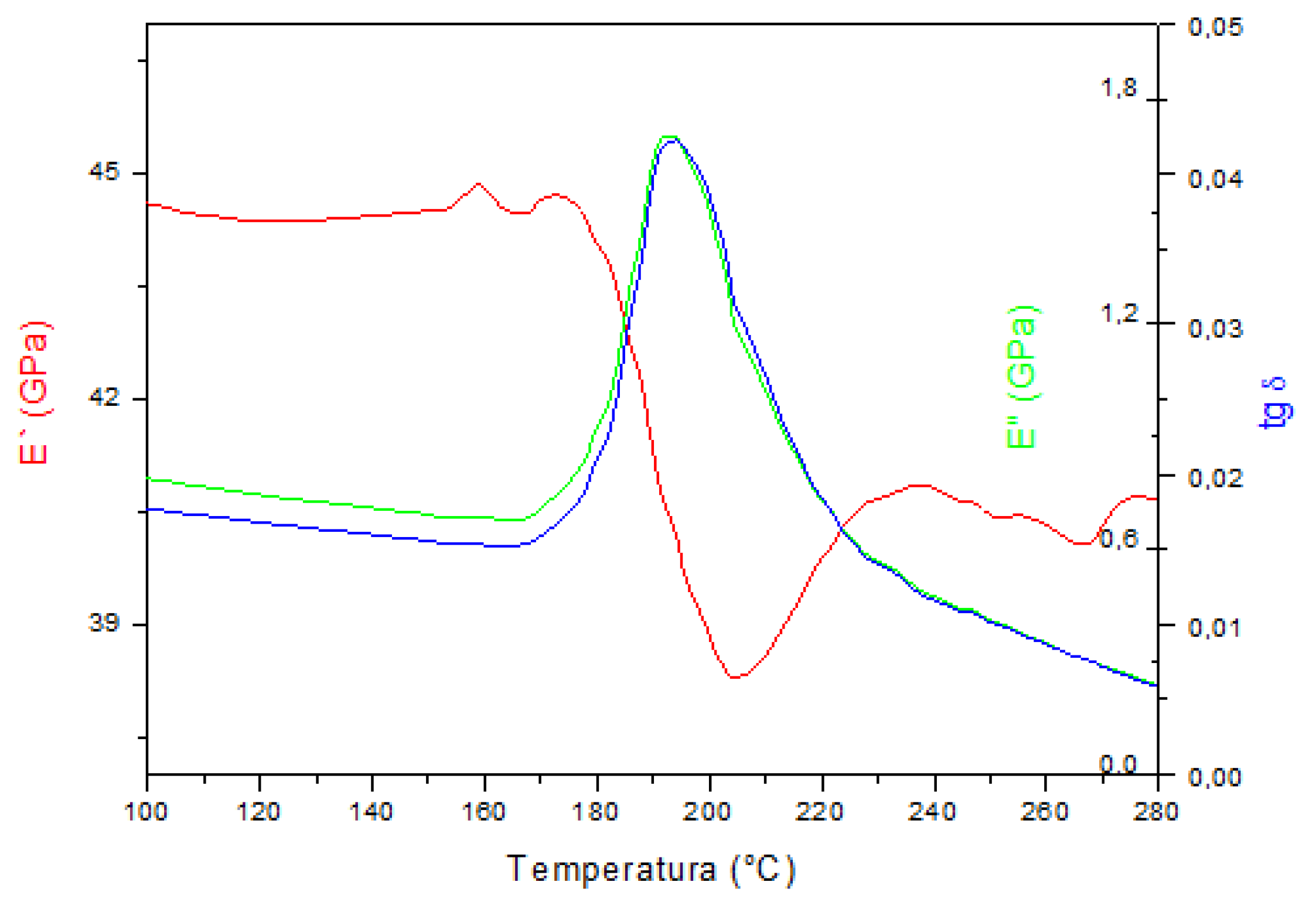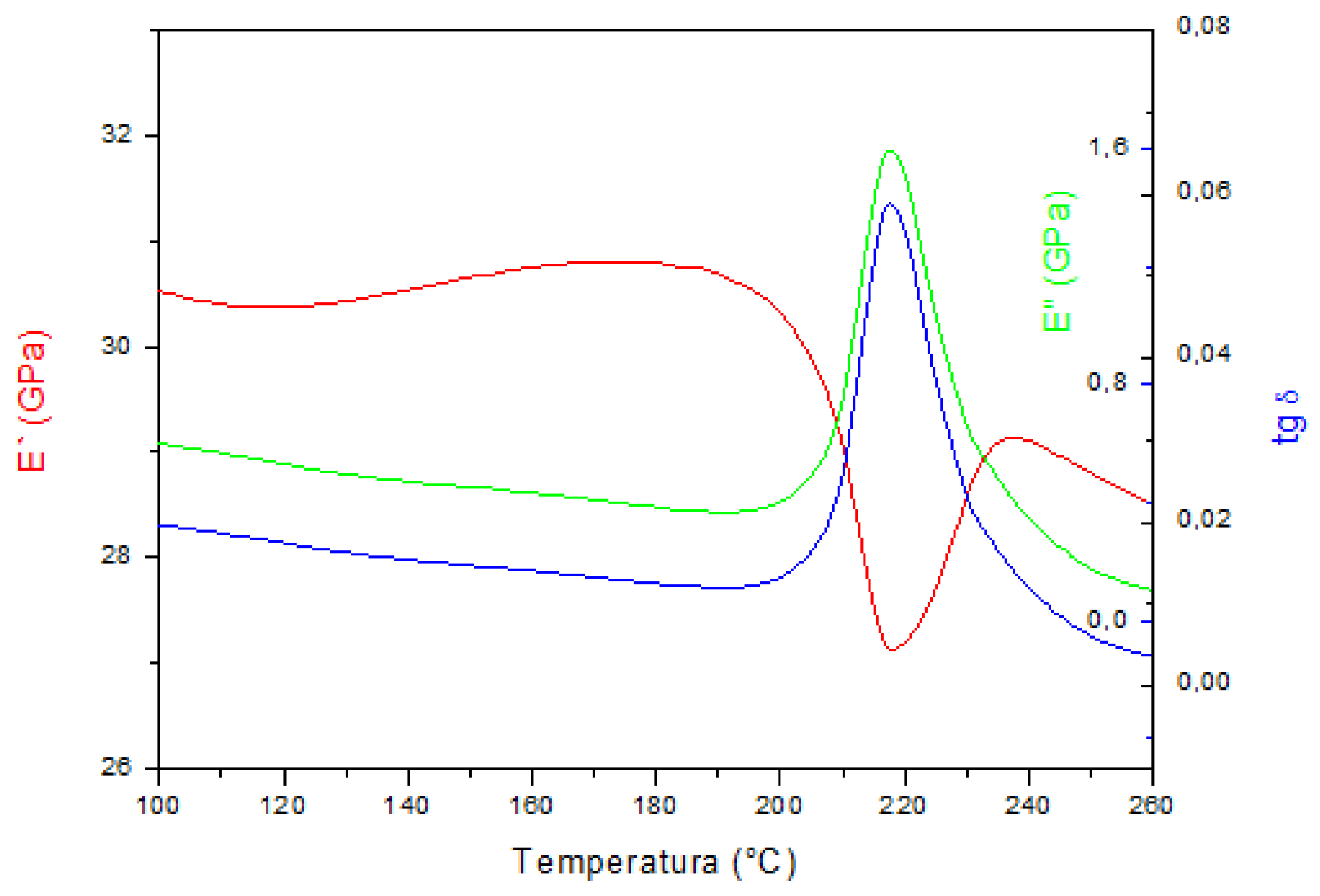The Effect of Heat Treatment on Damping Capacity and Mechanical Properties of CuAlNi Shape Memory Alloy
Abstract
:1. Introduction
2. Materials and Methods
3. Results and Discussion
3.1. Microstructural Analysis of CuAlNi Shape Memory Alloy
3.2. Results of Dynamic-Mechanical Analysis
3.3. Results of Mechanical Properties of the CuAlNi Shape Memory Alloy
4. Conclusions
- Microstructural analysis by light microscopy and scanning electron microscopy revealed the martensitic phase in the as-cast, solution annealed, and tempered state samples. The appearance of two types of martensite phases (β1′ and γ1′) was noted.
- Dynamic-mechanical analysis showed a higher damping capacity for samples after solution annealing and tempering. The newly formed interfacial boundaries of martensite (β1′ and γ1′ martensite) favorably affected the damping properties of the CuAlNi shape memory alloy.
- Results of the mechanical properties showed degradation of stress, strain, and hardness in the heat treated states due to large grain size, which appeared after the heat treatment process.
- Fractographic analysis showed a transgranular type of fracture in the as-cast state sample, transgranular and intergranular type of fracture in the solution annealing state, and mostly intergranular type of fracture in the tempered state sample. It can be concluded that the brittleness of the alloy arose from this heat treatment process.
Author Contributions
Funding
Institutional Review Board Statement
Informed Consent Statement
Data Availability Statement
Conflicts of Interest
References
- Mielczarek, A.; Kopp, N.; Riehemann, W. Ageing effects after heat treatment in Cu-Al-Mn shape memory alloys. Mater. Sci. Eng. A 2009, 521–522, 182–185. [Google Scholar] [CrossRef]
- Patoor, E.; Lagoudas, D.C.; Entchev, P.B.; Brinson, L.C.; Gao, X. Shape memory alloys, Part I: General properties and modeling of single crystals. Mech. Mater. 2006, 38, 391–429. [Google Scholar] [CrossRef]
- Suresh, N.; Ramamurty, U. Aging response and its effect on the functional properties of Cu-Al-Ni shape memory alloys. J. Alloys Compd. 2008, 449, 113–118. [Google Scholar] [CrossRef]
- Van Humbeeck, J. Damping capacity of thermoelastic martensite in shape memory alloys. J. Alloys Compd. 2003, 355, 58–64. [Google Scholar] [CrossRef]
- Sampath, V. Studies on the effect of grain refinement and thermal processing on shape memory characteristics of Cu-Al-Ni alloys. Smart Mater. Struct. 2005, 14, 253–260. [Google Scholar] [CrossRef]
- Sutou, Y.; Omori, T.; Koeda, N.; Kainuma, R.; Ishida, K. Effects of grain size and texture on damping properties of Cu–Al–Mn-based shape memory alloys. Mater. Sci. Eng. A 2006, 438–440, 743–746. [Google Scholar] [CrossRef]
- Otsuka, K.; Wayman, C.M. Shape Memory Materials; University of Cambridge: Cambridge, UK, 1998; pp. 27–36. [Google Scholar]
- Strittmatter, J.; Clipa, V.; Gheorghita, V.; Gümpel, P. Characterization of NiTi Shape Memory Damping Elements designed for Automotive Safety Systems. J. Mater. Eng. Perform. 2014, 23, 2696–2703. [Google Scholar] [CrossRef]
- Alaneme, K.K.; Umar, S. Mechanical behaviour and damping properties of Ni modified Cu-Zn-Al shape memory alloys. J. Sci. Adv. Mater. Dev. 2018, 3, 371–379. [Google Scholar] [CrossRef]
- Wu, S.K.; Chan, W.J.; Chang, S.H. Damping Characteristics of Inherent and Intrinsic Internal Friction of Cu-Zn-Al Shape Memory Alloys. Metals 2017, 7, 397. [Google Scholar] [CrossRef] [Green Version]
- Javanbakht, M.; Ghaedi, M.S. Interaction of martensitic transformations and vacancy diffusion at the nanoscale under thermal loading: A phase field model and simulations. Acta Mech. 2021, 232, 4567–4582. [Google Scholar] [CrossRef]
- Li, X.; Su, Y. A phase-field study of the martensitic detwinning in NiTi shape memory alloys under tension or compression. Acta Mech. 2020, 231, 1539–1557. [Google Scholar] [CrossRef]
- Xi, S.; Su, Y. A phase field study of the grain-size effect on the thermomechanical behavior of polycrystalline NiTi thin films. Acta Mech. 2021, 232, 4545–4566. [Google Scholar] [CrossRef]
- Ivanić, I.; Gojić, M.; Kožuh, S.; Kosec, B. Microstructural and Fractographic Analysis of CuAlNi Shape Memory Alloy before and after Heat Treatment. Defect Diffus. Forum 2020, 405, 100–106. [Google Scholar]
- Lexcellent, C. Shape-Memory Alloys Handbook; John Wiley & Sons: New York, NY, USA, 2013; pp. 16–25. [Google Scholar]
- Kök, M.; Qader, I.N.; Mohammed, S.S.; Öner, E.; Dağdelen, F.; Aydogdu, Y. Thermal stability and some thermodynamics analysis of heat treated quaternary CuAlNiTa shape memory alloy. Mater. Res. Express 2020, 7, 015702. [Google Scholar] [CrossRef]
- Gojić, M.; Kožuh, S.; Anžel, I.; Lojen, G.; Ivanić, I.; Kosec, B. Microstructural and phase analysis of CuAlNi shape-memory alloy after continuous casting. Mater. Technol. 2013, 47, 149–152. [Google Scholar]
- Sari, U.; Aksoy, I. Micro-structural analysis of self-accommodating martensites in Cu–11.92 wt%Al–3.78 wt%Ni shape memory alloy. J. Mater. Process. Technol. 2008, 195, 72–76. [Google Scholar] [CrossRef]
- Sari, U.; Aksoy, I. Electron microscopy study of 2H and 18R martensites in Cu-11.92 wt% Al-3.78 wt% Ni shape memory alloy. J. Alloys Compd. 2006, 417, 138–142. [Google Scholar] [CrossRef]
- Bashir, M.A. Use of Dynamic Mechanical Analysis (DMA) for Characterizing Interfacial Interactions in Filled Polymers. Solids 2021, 2, 108–120. [Google Scholar] [CrossRef]
- Holjevac Grgurić, T. Modificiranje i Stabilnost Plastomernih Mješavina sa Stiren-Etilen/Butilen-Stiren Blok Kopolimerom. Ph.D. Thesis, University of Zagreb Faculty of Chemical Engineering and Technology, Zagreb, Croatia, 19 September 2006. [Google Scholar]
- Ivanić, I.; Kožuh, S.; Holjevac Grgurić, T.; Kosec, B.; Gojić, M. The Influence of Heat Treatment on Microstructure and Phase Transformation Temperatures of Cu-Al-Ni Shape Memory Alloy. Chem. Ind. 2019, 68, 111–118. [Google Scholar] [CrossRef]
- Graczykowski, B.; Biskupski, P.; Mroz, B.; Mielcarek, S.; Nò, M.L.; San Juan, J. Elastic properties of Cu–Al–Ni shape memory alloys studied by dynamic mechanical analysis. Smart Mater. Struct. 2010, 19, 015010. [Google Scholar] [CrossRef]
- Ursanu, A.I.; Stanciu, S.; Pricop, B.; Săndulache, F.; Cimpoeșu, N. Dynamic mechanical analyze of superelastic CuMnAl shape memory alloy. Mater. Sci. Eng. 2016, 147, 012032. [Google Scholar]
- Chang, S.H. Influence of chemical composition on the damping characteristics of Cu-Al-Ni shape memory alloys. Mater. Chem. Phys. 2011, 125, 358–363. [Google Scholar] [CrossRef]
- Ivanić, I.; Kožuh, S.; Kurajica, S.; Kosec, B.; Anžel, I.; Gojić, M. XRD analysis of CuAlNi shape memory alloy before and after heat treatment. In Proceedings of the Mechanical Technologies and Structural Materials 2016, Split, Croatia, 22–23 September 2016; pp. 55–60. [Google Scholar]
- Zhang, Q.; Cui, B.; Sun, B.; Zhang, X.; Dong, Z.; Liu, Q.; Cui, T. Effect of Sm Doping on the Microstructure, Mechanical Properties and Shape Memory Effect of Cu-13.0Al-4.0Ni Alloy. Materials 2021, 14, 4007. [Google Scholar] [CrossRef]
- Ivanić, I.; Gojić, M.; Kožuh, S.; Kosec, B. Microstructural analysis of CuAlNiMn shape-memory alloy before and after the tensile testing. Mater. Tehnol. 2014, 48, 713–718. [Google Scholar]
- Sutou, Y.; Omori, T.; Kainuma, R.; Ono, N.; Ishida, K. Enhancement of superelasticity in Cu-Al-Mn-Ni shape-memory alloys by texture control. Metall. Mater. Trans. A 2002, 33, 2817–2824. [Google Scholar] [CrossRef]
- Sari, U. Influences of 2.5 wt% Mn addition on the microstructure and mechanical properties of Cu-Al-Ni shape memory alloys. Metall. Mater. 2010, 17, 192–198. [Google Scholar]
- Pushin, V.; Kuranova, N.; Marchenkova, E.; Pushin, A. Design and Development of Ti–Ni, Ni–Mn–Ga and Cu–Al–Ni-Based Alloys with High and Low Temperature Shape Memory Effects. Materials 2019, 12, 2616. [Google Scholar] [CrossRef] [Green Version]








| Sample | Tensile Strength, MPa | Elongation, % | Hardness, HV1 |
|---|---|---|---|
| L (as-cast state) | 475.5 ± 9.3 | 4.78 ± 0.28 | 344.0 ± 18.4 |
| K-2 (885 °C/60′/H2O) | 367.5 ± 48.8 | 2.72 ± 0.46 | 480.0 ± 25.0 |
| K-2-4 (885 °C/60′/H2O + 300 °C/60′/H2O) | 241.7 ± 11.9 | 1.36 ± 0.18 | 483.0 ± 14.4 |
Publisher’s Note: MDPI stays neutral with regard to jurisdictional claims in published maps and institutional affiliations. |
© 2022 by the authors. Licensee MDPI, Basel, Switzerland. This article is an open access article distributed under the terms and conditions of the Creative Commons Attribution (CC BY) license (https://creativecommons.org/licenses/by/4.0/).
Share and Cite
Ivanić, I.; Kožuh, S.; Grgurić, T.H.; Vrsalović, L.; Gojić, M. The Effect of Heat Treatment on Damping Capacity and Mechanical Properties of CuAlNi Shape Memory Alloy. Materials 2022, 15, 1825. https://doi.org/10.3390/ma15051825
Ivanić I, Kožuh S, Grgurić TH, Vrsalović L, Gojić M. The Effect of Heat Treatment on Damping Capacity and Mechanical Properties of CuAlNi Shape Memory Alloy. Materials. 2022; 15(5):1825. https://doi.org/10.3390/ma15051825
Chicago/Turabian StyleIvanić, Ivana, Stjepan Kožuh, Tamara Holjevac Grgurić, Ladislav Vrsalović, and Mirko Gojić. 2022. "The Effect of Heat Treatment on Damping Capacity and Mechanical Properties of CuAlNi Shape Memory Alloy" Materials 15, no. 5: 1825. https://doi.org/10.3390/ma15051825
APA StyleIvanić, I., Kožuh, S., Grgurić, T. H., Vrsalović, L., & Gojić, M. (2022). The Effect of Heat Treatment on Damping Capacity and Mechanical Properties of CuAlNi Shape Memory Alloy. Materials, 15(5), 1825. https://doi.org/10.3390/ma15051825







